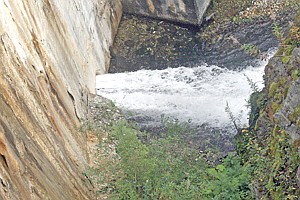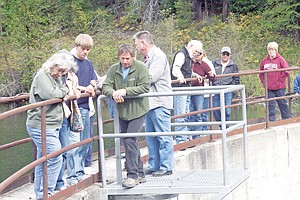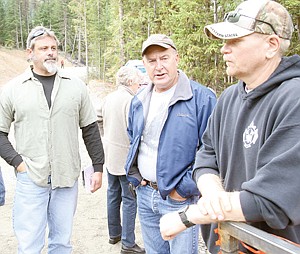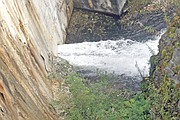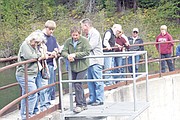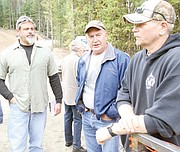Two busloads tour Flower Creek Dam
Two buses of about 85 people interested in the Flower Creek Dam took a 75-minute tour of the 67-year-old dam Saturday. Many of them were surprised at the poor condition of concrete arch structure.
In a preview of what was to come, a large, platter-size deposit of calcium carbonate was on display on a table in the Ponderosa Room of City Hall. The group gathered there before boarding buses to the dam site, just a few short miles to the structure and reservoir that is the sole source of water for Libby residents.
Mayor Doug Roll, City Council members and council candidates were among the attendees.
“I’m right in the path. I guess I should probably think about getting more sand,” said City Council candidate Brent Teske after reviewing the inundation map.
Copies of the map, which were provided by the Lincoln County Emergency Management Office, showed the area that could be affected should the Flower Creek Dam fail. The map, which was created in 2011, shows about a half-mile swatch of Libby from Wisconsin Avenue in the east to parts of Education Way in the west that would be affected.
Libby Council President Bill Bischoff previously said he fears for a loss of life should the dam fail.
Reasons for participating in the tour were varied, some curious and some just wanted to see for themselves the condition of the dam.
“I’m curious,” said Johnnie Beebe, who lives in rural Libby and is not a water customer. “I just want to see what the dam structure looks like, wondering whether it will take just $8 million. I’m also curious of the condition of the dam. I’ve felt all along this was worthwhile, and I’ve never questioned the repairs.”
Ken and Deanna Kehn agreed with Beebe that it’s time for a new structure.
“It is time that it should be replaced,” Deanna Kehn said. “I think it should be replaced soon, regardless of the impact of the grizzly bear and bull trout. I think it’s time we start to put people before animals. I do think the government is giving the city a bum rap. It’s too much.”
Having looked at the inundation map, Ken Kehn said the permitting process should take into consideration the condition of the dam.
“It needs to be replaced before there is a catastrophic flood,” Kehn said.
Judy Mattot is not a city resident, but she is a Libby city water customer.
“I’m really surprised at its (poor) condition,” Mattot said. “I’m surprised it’s still standing. I’ve seen stronger looking sand castles. It looks terrible.”
Mattot, who lives in Woodway Park, lives safely out of the inundation area.
“I’m just concerned for everyone,” she said.
Mayor Roll, who spoke briefly at the Ponderosa Room before buses were loaded, said he was happy to see the number of attendees.
“It’s a good turnout,” Roll said. “We advertised it well enough, I think. It’s good people show some interest.”
Saturday was the first day of fall, nearing the end of the construction season. Because of a permitting snafu, the city lost its summer construction time. Morrison Maierle, Inc., the engineering firm working with the city, is optimistic it can still move the project forward in 2013.
Recently, the biological assessment was completed and now is in the reviewing stage. Assuming that timeline, Roll is optimistic for a quick turnaround on the biological opinion, which follows the assessment.
“Hopefully — I said hopefully — we can see a biological opinion by the end of the month,” Roll said. “They’re actually working on these almost simultaneously.”
The biological opinion must be complete before a record of decision can be approved and construction can begin.
Without the proper permits to assure considerations for endangered species, such as grizzly bear and bull trout, the project enounctered delays and the clock expired for low-interest money from Rural Development, the funding arm of the U.S. Department of Agriculture.
The new dam will be different from the arc-like appearance of the current structure. Containing an estimated 14,000 cubic yards of concrete, the new dam will be a gravity structure with an estimated cost of $8.79 million, which includes survey, design, engineering, geotechnical and regulatory permitting costs.
The dam holds back an estimated 199 acre feet of water.



